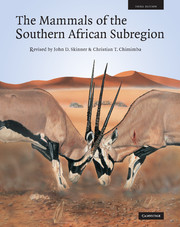Book contents
- Frontmatter
- Contents
- Editorial board
- Acknowledgements
- Foreword
- Preface
- The Mammal Research Institute
- R. H. N. Smithers
- Explanatory notes
- SUPERCOHORT AFROTHERIA
- COHORT PAENUNGULATA
- Order HYRACOIDEA
- Order PROBOSCIDEA
- Order SIRENIA
- SUPERCOHORT EUARCHONTAGLIRES COHORT GLIRES
- COHORT EUARCHONTA
- SUPERCOHORT LAURASIATHERIA
- COHORT FERUNGULATA
- Bibliography
- Appendix 1 Conservation status of southern African mammals
- Appendix 2 Colloquial names
- Index of scientific names
- Index of English colloquial names
- List of subscribers
- Plate Section
- Plate Section
- Plate Section
- Plate Section
- Plate Section
- Plate Section
- Plate Section
Order PROBOSCIDEA
from COHORT PAENUNGULATA
Published online by Cambridge University Press: 05 July 2013
- Frontmatter
- Contents
- Editorial board
- Acknowledgements
- Foreword
- Preface
- The Mammal Research Institute
- R. H. N. Smithers
- Explanatory notes
- SUPERCOHORT AFROTHERIA
- COHORT PAENUNGULATA
- Order HYRACOIDEA
- Order PROBOSCIDEA
- Order SIRENIA
- SUPERCOHORT EUARCHONTAGLIRES COHORT GLIRES
- COHORT EUARCHONTA
- SUPERCOHORT LAURASIATHERIA
- COHORT FERUNGULATA
- Bibliography
- Appendix 1 Conservation status of southern African mammals
- Appendix 2 Colloquial names
- Index of scientific names
- Index of English colloquial names
- List of subscribers
- Plate Section
- Plate Section
- Plate Section
- Plate Section
- Plate Section
- Plate Section
- Plate Section
Summary
THE EARLIEST KNOWN ancestor of the Proboscidea was a small pig-like creature named Moeritherium, whose fossil remains were found at Fayum in Egypt. It lived in swamp on the fringes of the Tethys Sea that covered parts of North Africa during the Eocene about 50 Mya. What is today the Sahara Desert was then a mosaic of swamp and plains. It stood about 0.6 m at the shoulder, had no trunk, but its teeth and skull marked it as an early representative of a wide range of proboscids that in later geological ages included the ancestors of present-day elephants. Many forms arose from the early proboscids, each adapting to the diverse niches open to them. On the basis of their fossil remains, these various forms have been classified into five families: the Moeritheridae, the Gomphotheridae, the Mastodontidae, the Dinotheridae and the Elephantidae. Only the Family Elephantidae still occurs today, all the others are extinct.
The true elephants, the Elephantidae, include modern elephants and two species of mammoths, the imperial mammoth (Mammuthus imperator) and the woolly mammoth (M. primigenius), both now extinct. As the colloquial name implies, the latter had a coat of fine, soft, yellow-brown hair, about 25 mm long, overlaid with a coat of long, coarse, dark rust-coloured hair about 500 mm long. They had very thick skin with a thick layer of fat underlying it, very small ears about 400 mm in length, and long, inwardly curving tusks.
- Type
- Chapter
- Information
- The Mammals of the Southern African Sub-region , pp. 51 - 59Publisher: Cambridge University PressPrint publication year: 2005



